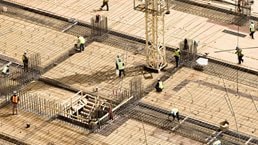In the highly people-dependent capital-project industry, a well-trained staff is essential for success. A good project director can mean the difference between profit and loss. But even experienced employees must augment their skills to keep up with digitization, automation, and changing data strategies—not to mention today’s sustainability challenges and new business practices.
Our yearlong research into next-generation project delivery methods revealed that sustained capability building and a redesigned talent pipeline are fundamental requirements for transforming the execution of large capital projects. Such projects are at the center of the global transition to net zero by 2050, so this type of transformation is now urgent. A plausible net-zero 2050 transition scenario envisions an average of $9.2 trillion a year to 2050 in capital spending on physical assets for energy and land use systems. An additional $1 trillion of today’s annual spending would have to be reallocated from high-emissions to low-emissions assets. To get the desired results from these investments, companies will need innovative approaches coupled with sophisticated stakeholder management—transforming capital-project delivery as we know it.
Yet systematically training and retaining qualified employees is an ongoing issue for most capital-project businesses. Many contractors claim they would like to offer regular, comprehensive training but add that they don’t know where to start or consider the problem just too big. After all, the industry is project based, decentralized, and fluid by nature. Employees rotate not only within companies but also across the sector, and resources are often subcontracted. Add acute labor shortages to the mix, and systematic capability building has become a significant hurdle.
In response, large capital-project companies can take a step up from project-by-project hiring by creating a broad capability-building program that addresses skill gaps across the employee base. Such a program can integrate skill-building efforts into day-to-day people development—including clear career paths and correlated training—and should be aligned with a company’s strategic priorities. A new program should also develop a mix of hard and soft skills and use virtual tools to connect the leadership with employees across the business.
This kind of systemic capability building can’t be an afterthought. With today’s labor mismatches, companies offering superior people development have an advantage. Don’t be left behind.
Hiring, training—and maintaining
Success in the capital-project industry rests heavily on the shoulders of its skilled employees. Companies have a continuing need for workers who can make rapid decisions, even with imperfect information; manage a growing set of stakeholders, from clients and subcontractors to local authorities; and proactively manage the risks, such as commodity price increases or supply chain disruptions affecting project schedules—to name two recent examples.
However, because construction companies typically hire staff only as needed, they rarely have strong incentives to develop the longer-term capabilities of the workforce. Instead, they traditionally default to training new employees by having them work side-by-side with more seasoned ones.
This approach had become more difficult even before the pandemic, when around 85 percent of the respondents in a global survey of industry leaders said that shortages of skilled labor were “highly important” to the industry. A mid-2021 survey of US general contractors found that nearly 90 percent of construction firms were experiencing project delays, which 61 percent of the respondents specifically attributed to labor shortages. A looming wave of retirements will probably increase the challenge, since more than 40 percent of the current US construction workforce is expected to retire by 2031.
Would you like to learn more about our Operations Practice?
The industry also has a rapidly growing need for workers with more advanced digital skill sets, given the number of new digital solutions in use for collaboration, back-office optimization, and on-site execution—including automation, AI, analytics, 3-D printing, modularization, and robotics. Done right, the technological transformation will create leaner, smarter decision-making processes. Nonetheless, recruiting workers with appropriate digital skills is a global cross-industry challenge.
As the industry begins to experience this next normal in construction, capital-project companies can hope to hire, train, and maintain a workforce that has the following three qualities:
- adaptability: receptive to change, able to adopt new methods quickly, and adept at executing projects involving more complex stakeholder ecosystems
- digital proficiency: able to adopt, understand, troubleshoot, and develop new digital workflows and solutions and to manage data securely, efficiently, and effectively
- business acumen: endowed with not only technical proficiency but also business sense, because this is an industry with a great deal of margin pressure
Projects require both hard and soft skills
Project leaders trying to complete work on time and on budget tend to focus mainly on short-term priorities and troubleshooting, and pay less attention to the long-term sustainability of the business. A great deal of training therefore takes place on the job. In addition, the industry tends to focus this training on hard skills like technical proficiency rather than soft ones, such as negotiating with counterparties, tackling unforeseen issues, communicating with the business, and resolving conflicts.
Yet soft skills generate valuable behavioral change with a lasting impact. These skills are especially needed when the nature of work is evolving quickly, as it is today. CEOs have ranked capability building among their top priorities (Exhibit 1).

The traditional approach to capability building won’t change overnight. Nonetheless, many large construction businesses have already taken strong steps in the right direction by setting up large transformation programs to develop business and leadership skills. Some have used ongoing training and career paths to integrate these programs into their overall people development system.
Focus on proven success factors
The experience of leading organizations that have created capability-building programs at scale reveals three important success factors.
Align capability-building programs with strategic priorities and goals. Organizations achieve more when they design their overall programs around a carefully chosen mix of projects rather than assume that the current composition of the project portfolio will continue into the future. Building skills takes time, and developing capabilities is especially important for supporting long-term goals—such as environmental-sustainability or digitization targets.
This approach holds true for individual projects as well. Organizations facing performance pressures often rush to accept and execute work. However, when a company begins a new undertaking—particularly one it has never executed before, such as a project involving a new technology, execution strategy, or geography—it’s best to take an early look at the capabilities required and to proceed accordingly. That means identifying any gaps and designing ad hoc workforce training to fill them. In most cases, this kind of effort can make it possible for a company to execute specific projects more accurately, on time, and on budget—and to develop its workforce appropriately.
Strive to build a mix of hard and soft skills. A number of highly sought-after skill sets can maximize productivity and the effectiveness of teams across the operations of a business. These include both hard skills like value engineering and soft skills, such as managing subcontractors.
Given the industry’s traditional emphasis on hard skills, leading organizations take steps to ensure that the workforce also values soft ones. The industry inherently demands a high level of soft skills because it needs frequent interactions with (and management of) many new and diverse stakeholders. Organizations can train their leaders and employees in these skills, which have a substantial impact when applied to specific projects, by providing company-wide programs on topics such as problem solving, change management, coaching, and collaboration.
In addition, companies can provide basic business knowledge to all employees, empowering them to confidently approach complex problems that may come up when projects are executed rather than relying on simplistic responses. Teaching employees how to increase a project’s value, develop a business case, or manage performance, for example, will boost their ability to solve complex problems by themselves.
Use virtual tools but encourage dynamic interactions. Virtual workshops can bridge both the physical and the psychological distance between leaders and employees—for example, by closing gaps between headquarters and on-site teams and between engineering teams and the construction workforce (Exhibit 2). The most effective workshops favor interactivity (such as the use of experiential-learning games or virtual breakouts to practice case examples) over content, because this approach enhances the employee experience. The people running the workshops should lean into technology, using it to generate excitement among participants, rather than apologize for it. Company leaders can also demonstrate their belief in and commitment to the program by being as visible as possible in virtual and in-person meetings. Note that self-paced digital-learning courses have proved to be powerful compliments to in-group learning modules.

Structuring the program
There are many ways to launch a successful capability-building program, depending on a company’s culture and needs. Four major archetypes reflecting the primary goals of these programs can help to shape their design (Exhibit 3).

Transformational capability building
This archetype is most relevant for company-wide efforts to transform capabilities, potentially as a workstream within a larger transformation process. Businesses following this archetype start by running a diagnostic to uncover capability gaps across the organization. These gaps typically fall in line with the main initiatives to boost a company’s performance through the larger transformation program. Companies working on procurement initiatives may, for example, find that they have gaps in negotiation skills, cleansheet cost engineering, or developing a business case.
With such gaps revealed, a company can create an organization-wide skill-building program—including broad and diverse content on both hard and soft skills—that offers all employees an opportunity to develop their capabilities. One Asian engineering and construction company, for example, designed an academy to run in parallel with its broader transformation effort. Within the academy, seven customized training modules offered implementation-based certification, as well as “field and forum” instruction in which classroom training was spread over a series of forums and fieldwork was assigned in between them. A certification process helped structure the program and motivate employees to join it.
The academy helped to fill the capability gaps and helped employees understand the changes taking place, preparing everyone for a more successful transformation. With company leaders and more than 45 project managers participating, the academy also served as the cornerstone of the larger change program. As one participant noted, “The academy was key to supporting the transformation—and genuinely embedding the changes in the company.”

Bridging the labor mismatch in US construction
Leadership development
This archetype, optimal for building leadership skills on a company or project level, has proved to be a powerful way of boosting performance. It has also been extremely valuable in supporting industries, such as construction, that usually underestimate the importance of soft skills.
For instance, one major engineering, procurement, and construction (EPC) company faced significant cultural differences among its employees after a merger—differences that hurt its profitability. In response, top management identified a series of soft-skill gaps preventing the newly merged organization from bridging the differences and achieving its full potential. These executives designed a customized capability-building program covering topics such as collaborative problem solving, root-cause analysis, and coaching and feedback. More than 30 managers acted as change agents for their teams. As one participant noted, the program “reinforced a sense of belonging, community, common values, and participation within the group.”
To ensure that the lessons learned during the program would be ingrained in the organization’s day-to-day business, the top executives also defined several actions that managers would take going forward. These included scheduling regular coaching and feedback sessions, holding monthly meetings to discuss progress and present success stories, and using team check-ins to agree on priorities for the week ahead.
Strategic reinforcement
This approach, increasingly important in today’s rapidly changing capital-project environment, focuses on a company’s core strategic direction and the new skills required to pursue it—which might include enhancing digital capabilities or understanding new green technologies. It applies equally well when applied to single business units or projects, or across the organization.
One global engineering and construction company, for instance, hoped to lead the industry’s digital transformation. It therefore needed to train employees throughout the company in the use of new digital technologies—a massive undertaking. To do so, it created a suite of digital training programs launched in waves to thousands of workers through virtual workshops, which it divided into two parts. The first was digital essentials, taught throughout the company; the second a series of specific capability modules for individual departments. The construction department, for example, was given a module on learning new technologies to execute projects on-site. When asked about this approach, the CEO observed that capabilities had to be developed in line with the company’s strategy: “after all, it’s our people who delivery the strategy.”
The company’s leadership, at every level, endorsed the program, creating a strong foundation for success. Providers of support ranged from HR partners, who led all aspects of the training, to dozens of volunteer in-house trainers across functions, hierarchies, and countries, who acted as faculty.
Project enhancement
The project enhancement archetype fills specific relevant skill gaps by introducing capability building in the ramp-up stage of very large projects. As each new project begins, companies using this archetype run a diagnostic to identify the specific skills required and then develop a customized approach to fill any gaps across the business. These gaps might be in the identification of time- and cost-saving initiatives, in subcontractor management, or in modularization.
A European EPC company in an increasingly competitive environment, for example, developed a program with a curriculum conveying both hard and soft skills tailored to each project’s context. Some projects required more technical capabilities; others focused on the project management team’s soft skills. For one lengthy multibillion-dollar project, upward of two dozen project staff members acted as change agents, undertaking more than 500 hours of virtual training over eight weeks after the project’s kickoff. Top facilitators with outstanding industry and company knowledge ensured that the program’s content was relatable and applicable to the daily activity of employees.
In the context of ramping up a project that would last more than four years, participants said they particularly valued the program. As one noted, it “helped in building the project team and getting to know each other,” adding that “it will help a lot when we need to collaborate to solve daily project challenges, such as identifying more value-engineering initiatives or revisiting our integrated planning strategy.”
Given today’s margin pressures, talent shortages, technological disruptions, and uncertainty in travel and working conditions, systemic capability-building is no longer an option; it is a necessity. Capital-project companies can begin to develop an appropriate capability-building program, then steadily integrate it into their day-to-day business over the medium to longer term, aligning it with a well-structured career path and offering it to employees as a value proposition. This important work promotes not only systemic capability building but also a common understanding of the way projects are executed—and helps to build a more resilient organization.


